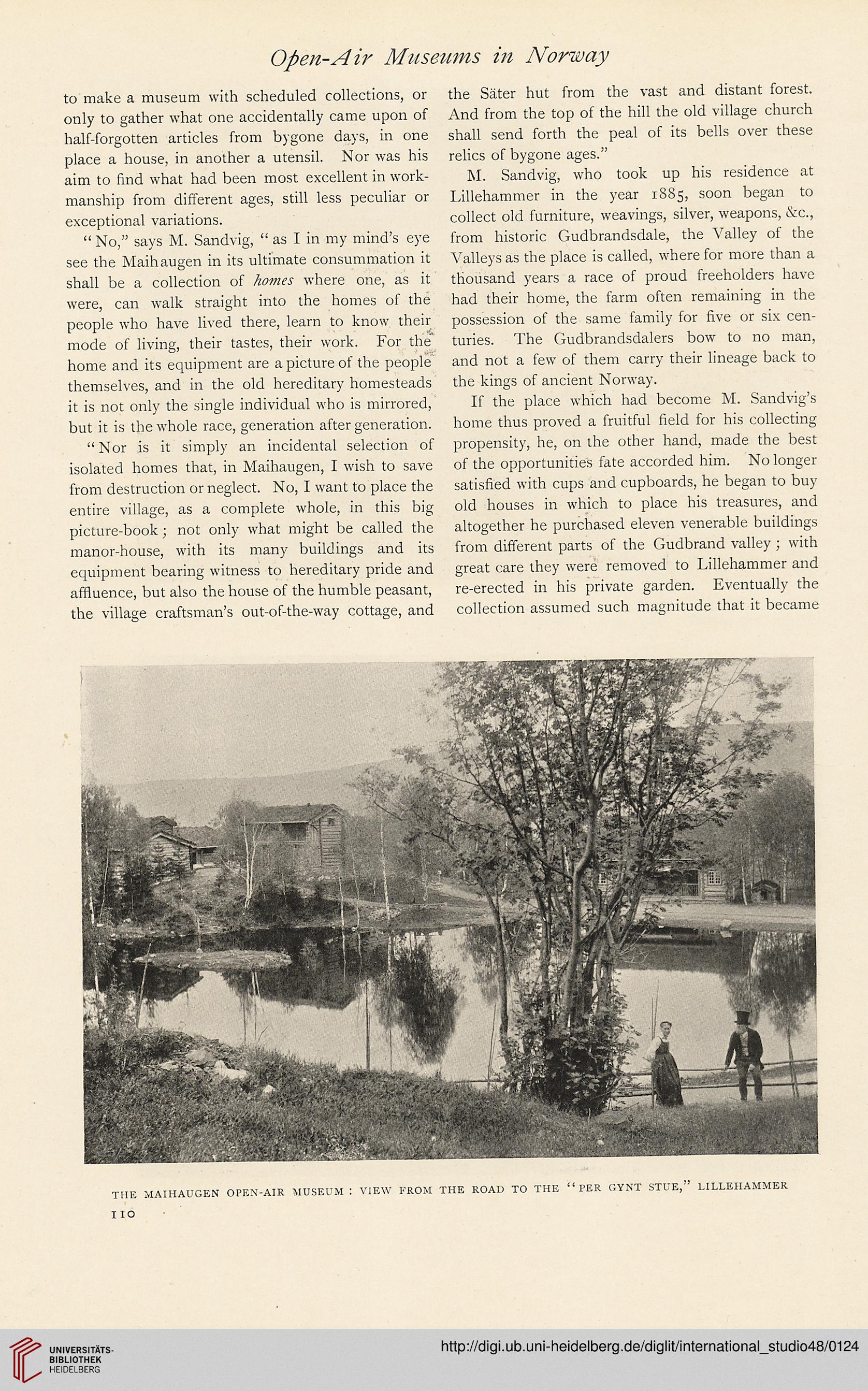Open-Air Museums in Norway
to make a museum with scheduled collections, or
only to gather what one accidentally came upon of
half-forgotten articles from bygone days, in one
place a house, in another a utensil. Nor was his
aim to find what had been most excellent in work-
manship from different ages, still less peculiar or
exceptional variations.
“ No,” says M. Sandvig, “ as I in my mind’s eye
see the Maihaugen in its ultimate consummation it
shall be a collection of homes where one, as it
were, can walk straight into the homes of the
people who have lived there, learn to know their
mode of living, their tastes, their work. For the'
home and its equipment are a picture of the people
themselves, and in the old hereditary homesteads
it is not only the single individual who is mirrored,
but it is the whole race, generation after generation.
“Nor is it simply an incidental selection of
isolated homes that, in Maihaugen, I wish to save
from destruction or neglect. No, I want to place the
entire village, as a complete whole, in this big
picture-book; not only what might be called the
manor-house, with its many buildings and its
equipment bearing witness to hereditary pride and
affluence, but also the house of the humble peasant,
the village craftsman’s out-of-the-way cottage, and
the Sater hut from the vast and distant forest.
And from the top of the hill the old village church
shall send forth the peal of its bells over these
relics of bygone ages.”
M. Sandvig, who took up his residence at
Lillehammer in the year 1885, soon began to
collect old furniture, weavings, silver, weapons, &c.,
from historic Gudbrandsdale, the Valley of the
Valleys as the place is called, where for more than a
thousand years a race of proud freeholders have
had their home, the farm often remaining in the
possession of the same family for five or six cen-
turies. The Gudbrandsdalers bow to no man,
and not a few of them carry their lineage back to
the kings of ancient Norway.
If the place which had become M. Sandvig’s
home thus proved a fruitful field for his collecting
propensity, he, on the other hand, made the best
of the opportunities fate accorded him. No longer
satisfied with cups and cupboards, he began to buy
old houses in which to place his treasures, and
altogether he purchased eleven venerable buildings
from different parts of the Gudbrand valley ; with
great care they were removed to Lillehammer and
re-erected in his private garden. Eventually the
collection assumed such magnitude that it became
THE MAIHAUGEN OPEN-AIR MUSEUM : VIEW FROM THE ROAD TO THE “PER GYNT STUE,” LILLEHAMMER
I IO
to make a museum with scheduled collections, or
only to gather what one accidentally came upon of
half-forgotten articles from bygone days, in one
place a house, in another a utensil. Nor was his
aim to find what had been most excellent in work-
manship from different ages, still less peculiar or
exceptional variations.
“ No,” says M. Sandvig, “ as I in my mind’s eye
see the Maihaugen in its ultimate consummation it
shall be a collection of homes where one, as it
were, can walk straight into the homes of the
people who have lived there, learn to know their
mode of living, their tastes, their work. For the'
home and its equipment are a picture of the people
themselves, and in the old hereditary homesteads
it is not only the single individual who is mirrored,
but it is the whole race, generation after generation.
“Nor is it simply an incidental selection of
isolated homes that, in Maihaugen, I wish to save
from destruction or neglect. No, I want to place the
entire village, as a complete whole, in this big
picture-book; not only what might be called the
manor-house, with its many buildings and its
equipment bearing witness to hereditary pride and
affluence, but also the house of the humble peasant,
the village craftsman’s out-of-the-way cottage, and
the Sater hut from the vast and distant forest.
And from the top of the hill the old village church
shall send forth the peal of its bells over these
relics of bygone ages.”
M. Sandvig, who took up his residence at
Lillehammer in the year 1885, soon began to
collect old furniture, weavings, silver, weapons, &c.,
from historic Gudbrandsdale, the Valley of the
Valleys as the place is called, where for more than a
thousand years a race of proud freeholders have
had their home, the farm often remaining in the
possession of the same family for five or six cen-
turies. The Gudbrandsdalers bow to no man,
and not a few of them carry their lineage back to
the kings of ancient Norway.
If the place which had become M. Sandvig’s
home thus proved a fruitful field for his collecting
propensity, he, on the other hand, made the best
of the opportunities fate accorded him. No longer
satisfied with cups and cupboards, he began to buy
old houses in which to place his treasures, and
altogether he purchased eleven venerable buildings
from different parts of the Gudbrand valley ; with
great care they were removed to Lillehammer and
re-erected in his private garden. Eventually the
collection assumed such magnitude that it became
THE MAIHAUGEN OPEN-AIR MUSEUM : VIEW FROM THE ROAD TO THE “PER GYNT STUE,” LILLEHAMMER
I IO




